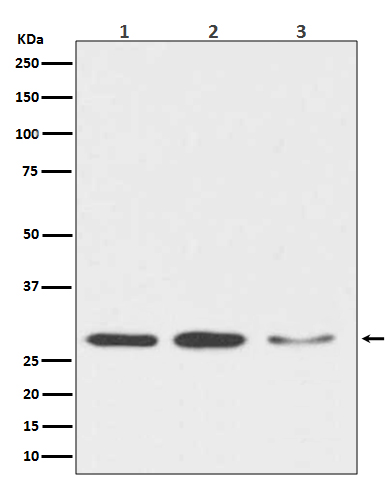
| WB | 咨询技术 | Human,Mouse,Rat |
| IF | 咨询技术 | Human,Mouse,Rat |
| IHC | 1/50-1/100 | Human,Mouse,Rat |
| ICC | 技术咨询 | Human,Mouse,Rat |
| FCM | 1/50-1/100 | Human,Mouse,Rat |
| Elisa | 咨询技术 | Human,Mouse,Rat |
| Aliases | DDIT3; CHOP; CHOP10; GADD153; DNA damage-inducible transcript 3 protein; DDIT-3; C/EBP-homologous protein; CHOP; C/EBP-homologous protein 10; CHOP-10; Growth arrest and DNA damage-inducible protein GADD153 |
| Entrez GeneID | 1649 |
| WB Predicted band size | Calculated MW: 19 kDa; Observed MW: 27 kDa |
| Host/Isotype | Rabbit IgG |
| Antibody Type | Primary antibody |
| Storage | Store at 4°C short term. Aliquot and store at -20°C long term. Avoid freeze/thaw cycles. |
| Species Reactivity | Human,Mouse,Rat |
| Immunogen | A synthesized peptide derived from human DDIT3 |
| Formulation | Purified antibody in PBS with 0.05% sodium azide. |
+ +
以下是关于DDIT3抗体的3篇参考文献,格式为文献名称、作者及摘要概括:
---
1. **"CHOP is involved in endoplasmic reticulum stress-induced apoptosis by enhancing DR5 expression in human carcinoma cells"**
*作者:Yamaguchi H, Wang HG*
摘要:研究揭示了内质网应激通过激活CHOP(DDIT3)上调死亡受体DR5.从而促进癌细胞凋亡。文中使用DDIT3抗体通过Western blot和免疫荧光验证CHOP在应激条件下的表达及定位。
---
2. **"The unfolded protein response: controlling cell fate decisions under ER stress and beyond"**
*作者:Walter P, Ron D*
摘要:综述了未折叠蛋白反应(UPR)的分子机制,重点讨论了CHOP(DDIT3)作为UPR关键调控因子的作用。作者通过DDIT3抗体的免疫组化实验,证明其在组织损伤模型中与细胞凋亡途径的关联。
---
3. **"Endoplasmic reticulum stress-mediated apoptosis in pancreatic β-cells by a saturated fatty acid"**
*作者:Ariyama Y, Tanaka N*
摘要:研究发现棕榈酸通过内质网应激诱导β细胞凋亡,机制涉及CHOP(DDIT3)通路的激活。研究采用DDIT3抗体进行免疫印迹分析,证实CHOP在脂毒性环境中的表达上调及促凋亡功能。
---
以上文献均包含DDIT3抗体的实验应用(如Western blot、免疫荧光等),并聚焦于其在细胞应激与凋亡中的分子机制。
The DDIT3 (DNA Damage-Inducible Transcript 3) antibody is a key tool for studying the protein encoded by the DDIT3 gene, also known as CHOP (C/EBP Homologous Protein) or GADD153 (Growth Arrest and DNA Damage-inducible 153). DDIT3 is a stress-inducible nuclear protein that belongs to the C/EBP family of transcription factors. It is primarily activated in response to endoplasmic reticulum (ER) stress, hypoxia, DNA damage, or nutrient deprivation, playing a central role in apoptosis and cellular stress responses.
DDIT3 antibodies are widely used in research to detect and quantify this protein in techniques such as Western blotting, immunohistochemistry (IHC), and immunofluorescence (IF). They help investigate its role in diseases linked to ER stress, including cancer, diabetes, neurodegenerative disorders, and ischemic injury. For instance, DDIT3 is implicated in tumor progression and chemoresistance, making it a therapeutic target in oncology.
These antibodies typically recognize human, mouse, or rat DDIT3. with common host species being rabbit or mouse. Validation often includes testing in cell models (e.g., human cell lines treated with ER stress inducers like tunicamycin). Researchers rely on DDIT3 antibodies to explore its interactions with partners like ATF4 or its ability to form heterodimers that inhibit transcriptional activity. Proper controls, such as knockout cells or induced stress conditions, are critical to ensure specificity. Overall, DDIT3 antibodies are essential for unraveling stress-response mechanisms and their pathological implications.
×